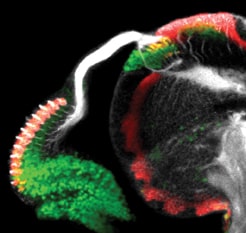Scientists at the Weizmann Institute of Science recently showed that there is a hitherto unknown "means of transportation" that offers its services to molecules that want to move along the axons of nerve cells. This is an internal system of membranes called endoplasmic reticulum.

The nerve cell is a real engineering marvel: molecules transmit signals and other substances that are formed in the cell body to enormous distances along the cell extensions (axons). For comparison, if the width of the nerve cell body was about a meter, the length of the long axons could reach tens of kilometers.
To ensure the rapid movement of molecules across these impressive distances, the molecules use the rigid internal framework of the cell skeleton, which gives the cell its shape and serves as a set of railroad tracks on which transport along the axon takes place.
A molecule that needs to reach the end of the axon will usually make its way along the cytoskeleton, inside a "carriage" which is a tiny vesicle.
But scientists at the Weizmann Institute of Science recently showed that there is a completely different "means of transportation" that offers its services to molecules that want to move along the axons of nerve cells. This is an internal system of membranes called endoplasmic reticulum.

It is a large cellular organelle that is able to store and even produce various substances. It wraps the cell nucleus, but also extends along the cytoskeleton, reaching different parts of the cell.
This discovery, recently published in the online scientific journal PLoS Biology, emerged from a study conducted by research student Shaul Yogev together with Dr. Eil Schechter, in the laboratory of Prof. Ben-Zion Shilo in the Department of Molecular Genetics at the Weizmann Institute of Science.
The research was carried out in maggots of the Drosophila fly.
The scientists focused on a signal-transmitting molecule that is essential for communication between the eye and the brain, and belongs to a family of proteins called "epidermal growth factors", which play key roles in the growth and survival of cells in mammals. It turns out that this molecule, which is formed in the body of the nerve cell, "travels" inside the endoplasmic reticulum to the end of the axon. It makes its way accompanied by two assistants: a molecular "bodyguard" that protects it from damage, and an enzyme that cuts its connection to the cell when it reaches the end of the axon, thus allowing it to exit the nerve cell.

The scientists tracked the trio's movements using fluorescent markers. In further experiments, they eliminated the presence of the cutting enzyme through genetic manipulation within the endoplasmic reticulum. As a result, the signaling molecule was not released from the nerve cell at all, which proves that its normal pathway must indeed pass through the endoplasmic reticulum, and not through other parts of the cell.
Although the research was carried out in fruit flies, the findings are relevant to mammals, including humans. The exact clarification of the passage of signals within nerve cells may contribute to understanding the function of these cells in health and disease states.

2 תגובות
Enough with the naivety.
The Weizmann Institute is known for its cruelty to animals. There is no need to naively excuse that the experiment was performed entirely on a fly. Thousands of animals lost their lives in agony on the frozen death tables at the Weizmann Institute.